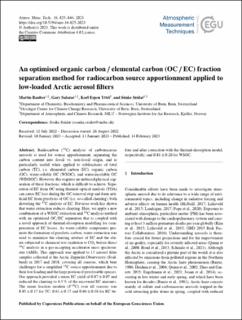| dc.contributor.author | Rauber, Martin | |
| dc.contributor.author | Salazar, Gary | |
| dc.contributor.author | Yttri, Karl Espen | |
| dc.contributor.author | Szidat, Sönke | |
| dc.date.accessioned | 2023-02-17T09:07:57Z | |
| dc.date.available | 2023-02-17T09:07:57Z | |
| dc.date.created | 2023-02-14T16:06:06Z | |
| dc.date.issued | 2023 | |
| dc.identifier.citation | Atmospheric Measurement Techniques. 2023, 16, 825-844. | en_US |
| dc.identifier.issn | 1867-1381 | |
| dc.identifier.uri | https://hdl.handle.net/11250/3051820 | |
| dc.description.abstract | Radiocarbon (14C) analysis of carbonaceous aerosols is used for source apportionment, separating the carbon content into fossil vs. non-fossil origin, and is particularly useful when applied to subfractions of total carbon (TC), i.e. elemental carbon (EC), organic carbon (OC), water-soluble OC (WSOC), and water-insoluble OC (WINSOC). However, this requires an unbiased physical separation of these fractions, which is difficult to achieve. Separation of EC from OC using thermal–optical analysis (TOA) can cause EC loss during the OC removal step and form artificial EC from pyrolysis of OC (i.e. so-called charring), both distorting the 14C analysis of EC. Previous work has shown that water extraction reduces charring. Here, we apply a new combination of a WSOC extraction and 14C analysis method with an optimised separation that is coupled with a novel approach of thermal-desorption modelling for compensation of EC losses. As water-soluble components promote the formation of pyrolytic carbon, water extraction was used to minimise the charring artefact of EC and the eluate subjected to chemical wet oxidation to CO2 before direct 14C analysis in a gas-accepting accelerator mass spectrometer (AMS). This approach was applied to 13 aerosol filter samples collected at the Arctic Zeppelin Observatory (Svalbard) in 2017 and 2018, covering all seasons, which bear challenges for a simplified 14C source apportionment due to their low loading and the large portion of pyrolysable species. Our approach provided a mean EC yield of 0.87±0.07 and reduced the charring to 6.5 % of the recovered EC amounts. The mean fraction modern (F14C) over all seasons was 0.85±0.17 for TC; 0.61±0.17 and 0.66±0.16 for EC before and after correction with the thermal-desorption model, respectively; and 0.81±0.20 for WSOC. | en_US |
| dc.language.iso | eng | en_US |
| dc.rights | Navngivelse 4.0 Internasjonal | * |
| dc.rights.uri | http://creativecommons.org/licenses/by/4.0/deed.no | * |
| dc.title | An optimised organic carbon∕elemental carbon (OC∕EC) fraction separation method for radiocarbon source apportionment applied to low-loaded Arctic aerosol filters | en_US |
| dc.title.alternative | An optimised organic carbon∕elemental carbon (OC∕EC) fraction separation method for radiocarbon source apportionment applied to low-loaded Arctic aerosol filters | en_US |
| dc.type | Peer reviewed | en_US |
| dc.type | Journal article | en_US |
| dc.description.version | publishedVersion | en_US |
| dc.rights.holder | © Author(s) 2023. | en_US |
| dc.source.pagenumber | 825-844 | en_US |
| dc.source.volume | 16 | en_US |
| dc.source.journal | Atmospheric Measurement Techniques | en_US |
| dc.identifier.doi | 10.5194/amt-16-825-2023 | |
| dc.identifier.cristin | 2126069 | |
| dc.relation.project | NILU - Norsk institutt for luftforskning: 115058 | en_US |
| cristin.ispublished | true | |
| cristin.fulltext | original | |
| cristin.qualitycode | 1 | |

